A Lush Landscape
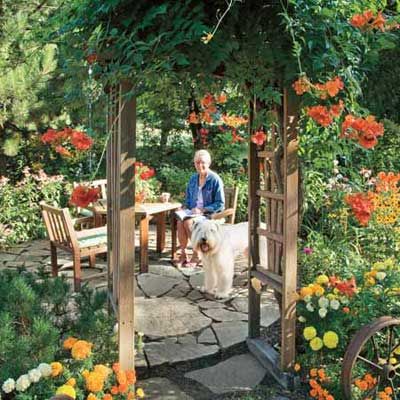
You’ve probably read that a well-designed garden starts with an overall plan. And that having one can save you a lot of grief. Susan Martin agrees—though she transformed her own acre of scrubby trees and lawn into a colorful garden without ever putting pencil to paper. Instead of following a paint-by-numbers planting scheme, Susan simply experimented and watched to see what worked and what didn’t.
In the process, she discovered tricks that can help gardeners who don’t think in terms of grid lines and circles on paper. They’re also good for homeowners like herself who start out just wanting a few flowers but discover how much they enjoy the process and wind up tackling the whole yard. Here, the trial-and-error lessons she learned in creating her stunning landscape.
Shown: The trumpet vine on the entry arbor is ”a hummingbird magnet,” Susan says.
Before: Blank-Slate Backyard
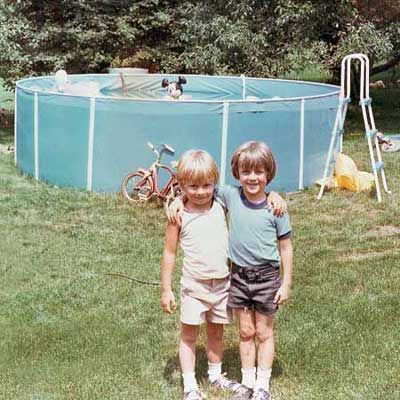
Susan didn’t grow up gardening, and when her two children were young she had no time to do much outside the home her husband, Dave, built 38 years ago. Their suburban Illinois yard was mostly lawn. But when the kids outgrew an aboveground pool, Susan decided to replace it with a patio.
Instead of hiring a stonemason or a landscaping crew or even consulting a how-to book, she just ordered up a load of brown flagstones and moved them one by one in her wheelbarrow, setting them down on the well-packed sand base on which the pool had stood. Some of the slabs were really heavy—she guesses 50 to 70 pounds—but with her teenage daughter working alongside, Susan was able to create a level surface by scooping out sand where needed to accommodate the different thicknesses. “It was amazing to me,” she says. “When you looked at that pile of flagstones, you’d think they’d never fit together. But they did, like a jigsaw puzzle. We just scooched them in.” She didn’t have to make a single cut.
Shown: Susan Martin laid a do-it-yourself stone patio where her children’s aboveground pool once stood.
It Grows On You
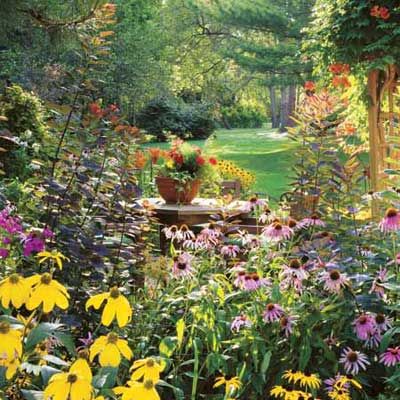
Flushed with that success, Susan decided to surround the patio with a flower bed 3 feet wide. “Oh, my gosh!” she recalls thinking as she watched the blooming coneflowers grow. Gardening was so satisfying that she decided to convert another patch of lawn into a flower bed. Then another patch, and another, adding decorative flea-market finds as she collected them.
Shown: Sun-loving perennials surround the flagstone patio; a remaining patch of lawn in back is ringed with shrubs and trees. Creating different garden areas makes the 1-acre yard seem even larger than it is.
Add Privacy with Plantings
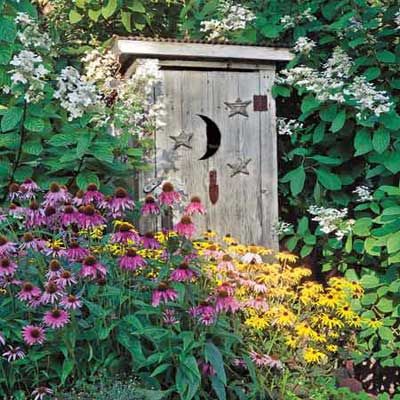
While Susan had no plan at the start, one did emerge, though she never formalized it. She had two key goals: in the front, to screen out the view of the street from the kitchen and dining room windows, as well as the sunny spot directly outside where she had a table and chairs; in back, to block views of neighboring houses completely so that the yard would be a private retreat.
Shown: An old outhouse, bought at a fair flea market, serves as both a storage shed and a decorative object in the yard.
Taming the Trees
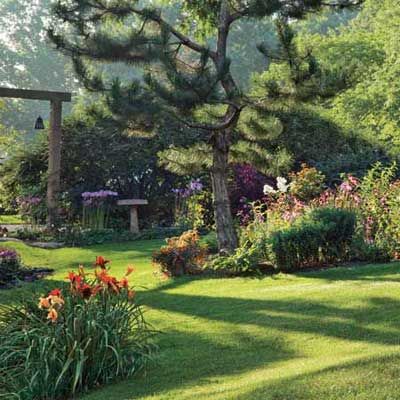
Accomplishing her goal for the front took a little trial and error. She first put in a flower bed as a screen, but it wasn’t enough. So she planted three Austrian pines. “They were only 4 feet tall, just perfect,” Susan says. “It didn’t dawn on me how quickly 10 years would pass.” Over time, the trees grew into a wall looming over the house. So a little over a year ago, she took out two and pruned the remaining one, which has a crooked trunk, to look like a bonsai. “It still shelters the patio, but only a little.”
Shown: On the south-facing side of the house, the single Austrian pine stands like an overgrown bonsai, and a large rectangular arch connects the front deck to the driveway.
Salvage Garden Art
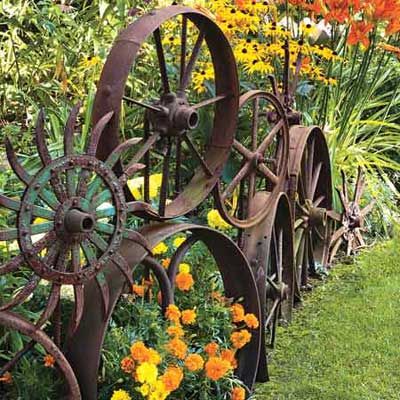
In the backyard, creating privacy was easy. Along the edges she planted shrubs, which have filled in nicely. At some point during all this work, Susan recalls her husband asking, “What are you doing here?” The answer is now clear: Bit by bit, she was transforming the lawn into a mere backdrop for an exuberant mix of flowers and garden art.
Shown: Susan collected old metal wheels at flea markets for years and finally had enough to wire together as edging to set off planting beds. She used rebar stakes behind the wheels to keep the assembly from tipping.
Not Just For the Birds
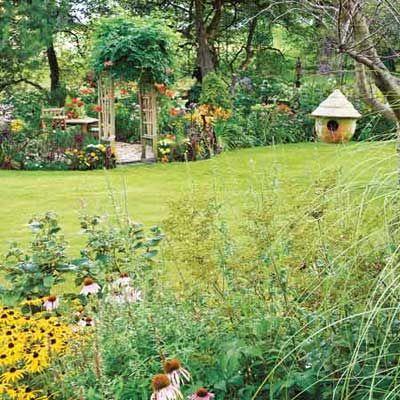
Today, she walks through her wildlife-friendly wonderland delighting in the birds and butterflies it draws. From the first spring bulbs to the roses of June and through the cascade of daylilies and coneflowers in summer, a rolling display unfolds every season.
Shown: Jenny wrens nest each year in the birdhouse above this bed of coneflowers and black-eyed Susans.
Four-Season Garden
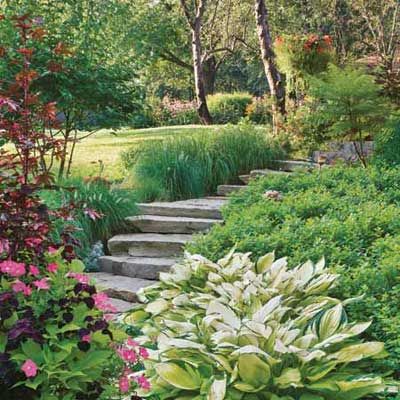
The growers continue to put on a show, even when the growing season ends. Susan resists the urge to whisk away the remains. “The dried flower heads and tall grasses look so pretty in fall,” she says. “And in winter, the dried hydrangeas are lovely in the snow.”
Her learn-as-you-go, no-plan approach has yielded what all gardeners aim for: a four-season garden full of color and texture.
Shown: On the east side of the house, stone steps climb from the walk-out basement and backyard up to the front of the house.
Time-Tested Tips From Susan’s Garden
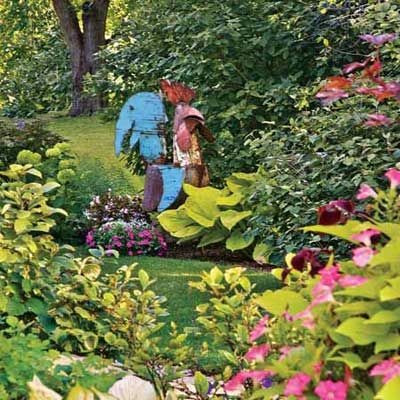
Here are some lessons Susan Martin learned as she grew her garden. What worked for her can work for you, too.
Move Plants at Will
Instead of trying to work out every detail on paper before you plant, you can use actual blooms as your way of seeing color combinations that dazzle. Susan discovered that she can move plants even while they are blooming, provided she’s willing to let that season’s blossoms droop. “Gardening books say not to move plants during the summer,” she says. “But if you really water them the day before, you can do it quite successfully.” She takes care to keep as much dirt as possible around the roots, and to move plants via her wheelbarrow to their new home right away. Even if flowers fall off, the plants do fine the next season. And there’s no risk you’ll forget what you wanted to switch.
Shown: Gus, a 5-foot-tall salvaged metal rooster, presides over part of the backyard.
Time-Tested Tips: Consolidate Beds
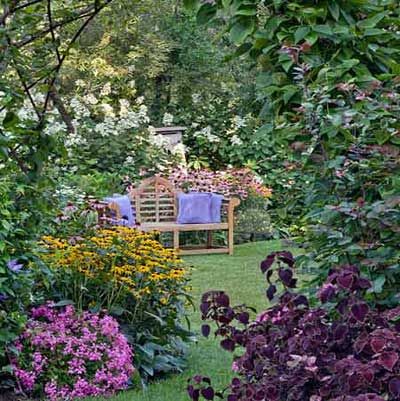
If you start small and add new beds each year, you can wind up with a garden that looks a bit scattered. Susan discovered this after she put in several flower beds along the front of her property, each separated by about 8 feet of lawn. An easy fix: Join them together. “One big bed looks better than three small ones,” Susan says. “It creates more of a flowing look.”
Shown: Purple coleus leaves and coneflowers flank the entry to a beautiful outdoor seating area.
Time-Tested Tips: Use Art, But Edit It
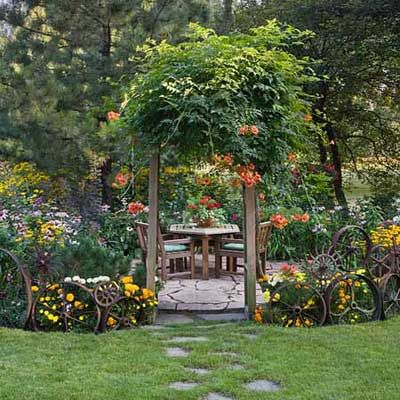
Sculptures, antique farm implements, and other art elements add pizzazz and
a personal touch to a garden. But if you want them to work as accents, not background noise, you have to choose carefully. Susan used to display everything she received as gifts or found at flea markets. Then a visitor to her garden made a remark about “tchotchkes,” and she realized her garden had become too cluttered. She edited down her display and now features a single large piece in each bed. A tall metal rooster presides over one area. An outhouse storage shed serves as a focal point for another. She turned rusty metal wheels into edging for flower beds around the patio. Pots are displayed in an old goat cart and a wood wheelbarrow elsewhere on the property.
Shown: Susan used salvaged metal wheels to build this stunning garden edging.
Time-Tested Tips: Bed Perennials, Pot Annuals
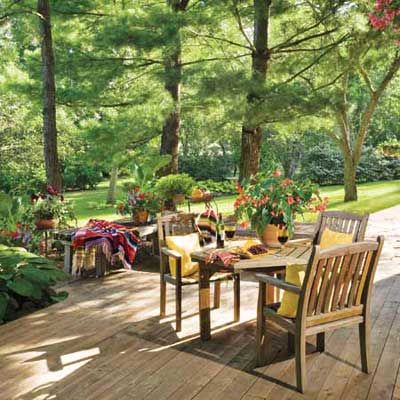
You can have lots of flowers by growing annuals. But then you have to replant each year, and you have to battle more weeds, since all that digging exposes weed seeds to sunlight. Susan used to go heavy on annuals but learned that perennials require a lot less work. So now she devotes most of her garden beds to plants that come back year after year and just need tidying up once in a while. She still shops for annuals, but mostly to put into pots.
Shown: A centerpiece of dragonwing begonias draws attention on the back deck’s dining table. Overhead, hanging pots overflow with angel-wing begonias, a favorite for their showy flowers, rapid growth, and ability to thrive in shade or partial sun.
Time-Tested Tips: Savor the Last Morsels
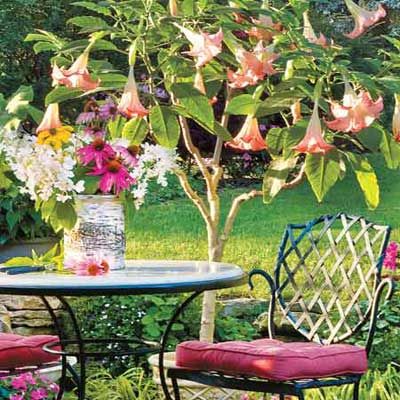
Don’t rush to cut back late-season blooms. “Dried flower heads and tall ornamental grasses look so lovely in the fall and winter,” Susan says—and it’s fun to watch birds flit from flower head to flower head as they harvest seeds.
Shown: Brugmansia, or angel trumpet, is the showstopper by
the front deck. Because it isn’t cold-hardy where she lives, in the fall Susan wheels the potted tree into the garage, where it overwinters.
